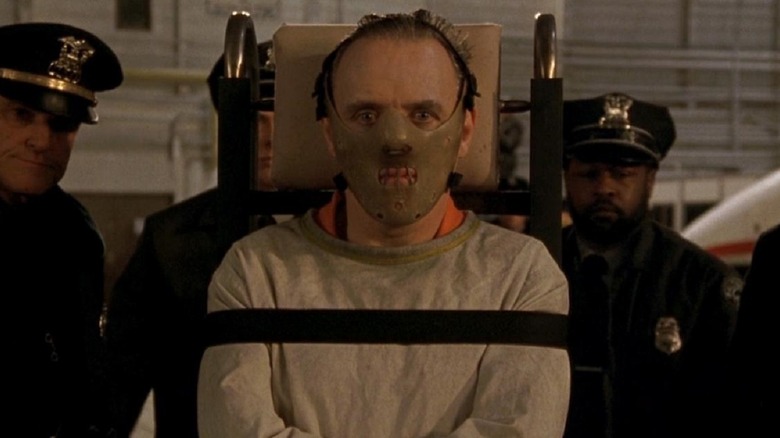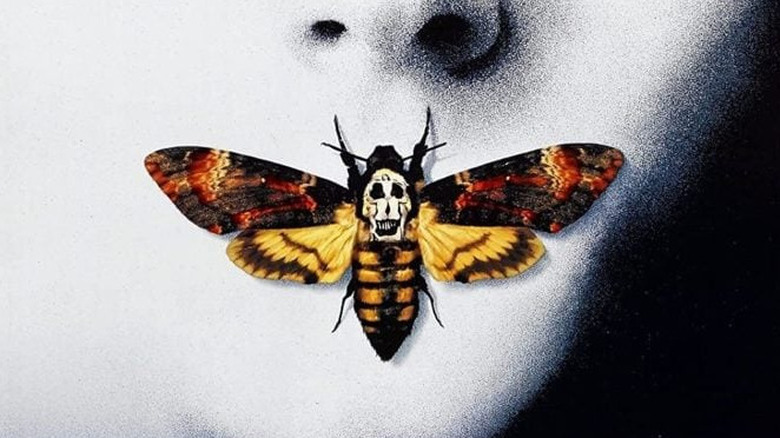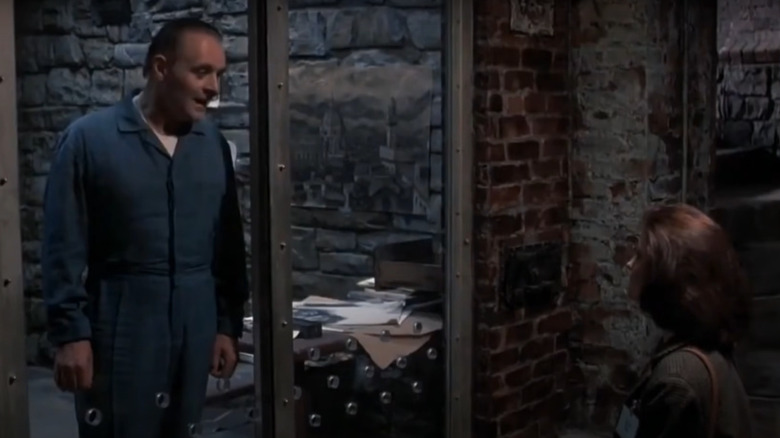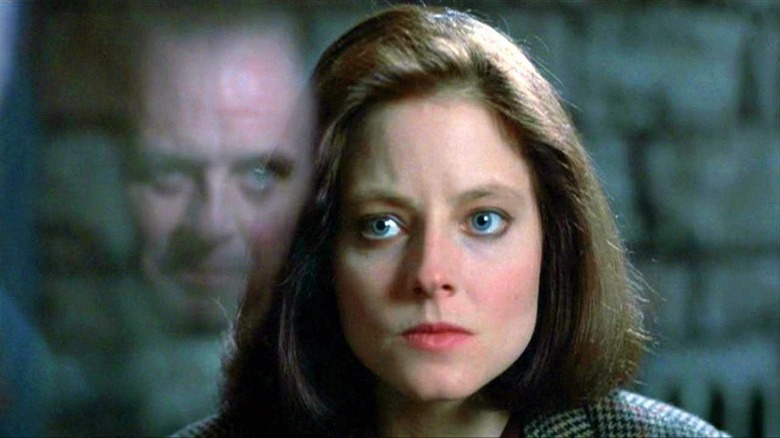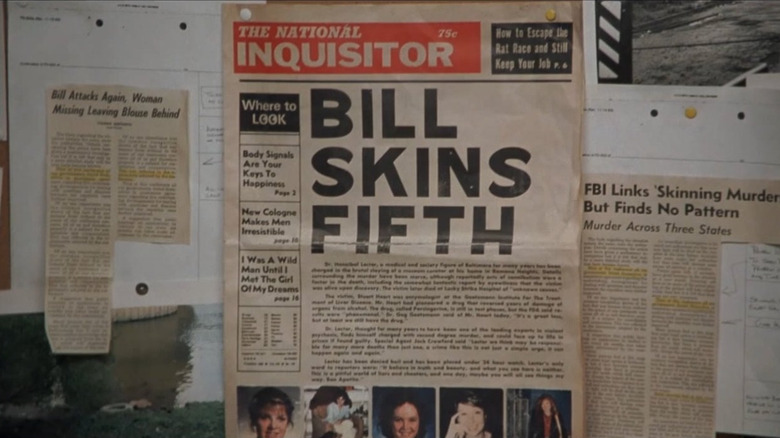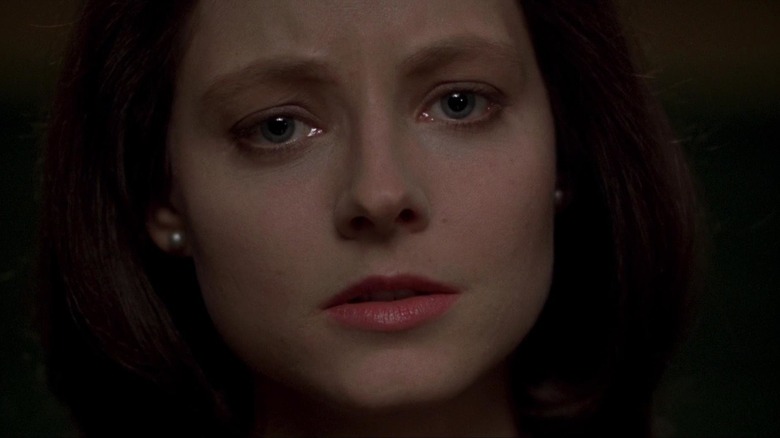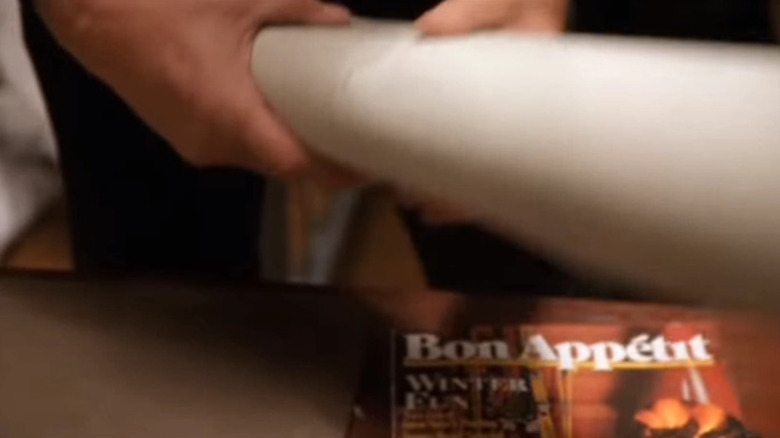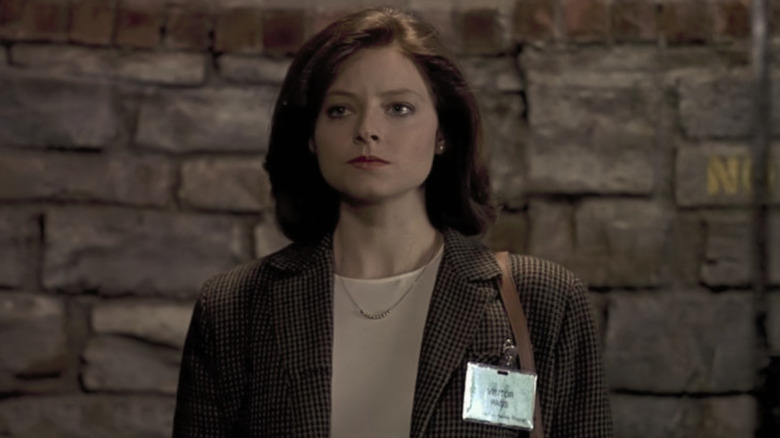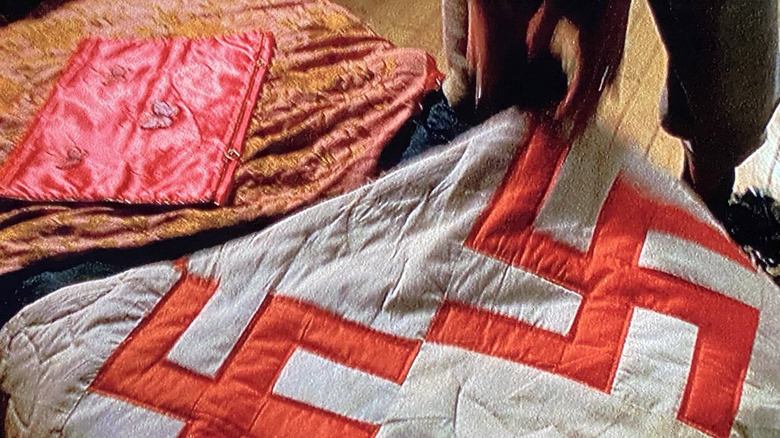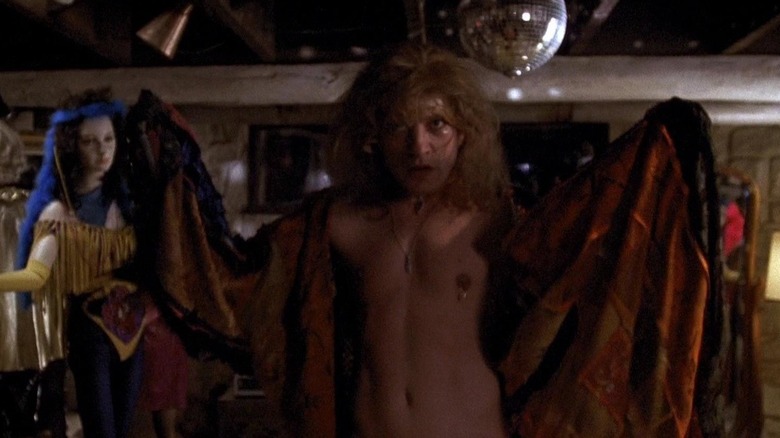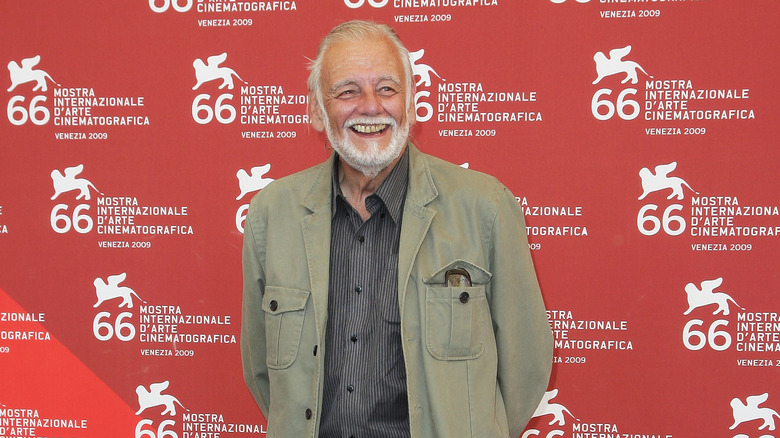Hidden Details In The Silence Of The Lambs You May Have Missed
"The Silence of the Lambs" has had a huge impact on pop culture since its release in 1991. Fans of the movie can agree that its tense atmosphere, disturbing plot, and realistic characters set it apart from many other films out there. Directed by Jonathan Demme, the movie follows FBI agent trainee Clarice Starling (Jodie Foster) as she tries to track down the notorious serial killer Buffalo Bill (Ted Levine). In hopes of getting clues about the case, she talks to Dr. Hannibal Lecter (Anthony Hopkins), a forensic psychiatrist who has murdered and eaten several victims. As a character, Hannibal made viewers realize that serial killers can be very intelligent and even-tempered rather than many others who fly into a rage and commit crimes seemingly on a whim.
Despite only appearing on screen for 16 minutes out of the movie's nearly 2-hour runtime, Hopkins' chilling performance earned him the best actor award at the 1991 Academy Awards. The film also won a number of other awards that year, including best actress for Foster's performance and best adapted screenplay. While "The Silence of the Lambs" is widely popular, there are still some Easter eggs throughout the movie that even the most avid viewer may have missed. If you want to gain a deeper perspective on this incredible film, sit back and savor these hidden details with some fava beans and a nice Chianti.
Warning: This article contains spoilers.
The skull in the movie's poster is made of several naked bodies
The first Easter egg isn't actually in the movie, but rather in its iconic poster. The poster is instantly recognizable from the close-up of Clarice's face with her mouth covered by a death's-head moth. But did you know that the skull design on the moth's back is actually made out of several naked bodies? It isn't easy to spot from a distance, but if you zoom in, you can see that it's been hidden in plain sight the whole time.
The design pays homage to a photo captured by surreal artist Salvador Dali and photographer Philippe Halsman called "In Voluptas Mors" or "Voluptuous Death." Like the design in the movie's poster, "In Voluptas Mors" features multiple naked women positioned in a way that closely resembles a skull. The filmmakers most likely did this to emphasize the way female characters' bodies were linked to their untimely deaths — Buffalo Bill chose women as his victims so he could skin them, make a suit out of their skin, and wear it to feel more like a woman.
The artwork in Hannibal's cell contains hidden clues
The first meeting between Clarice and Hannibal is one of the most memorable moments in the movie, and there are several major clues hidden in the artwork in Hannibal's cell. When Clarice meets Hannibal, she notices the drawings hanging on the walls and asks if he did them himself. He explains that one of his drawings depicts the Duomo as seen from the Belvedere in Florence, Italy. This might seem random and insignificant to someone watching the movie for the first time, but it takes on a new meaning upon rewatching the film.
The artwork foreshadows where Hannibal ends up after making his great escape. At the end of the movie, after Hannibal breaks out of his cell and avoids recapture, he can be seen walking amongst a crowd in Florence. On top of that, the artwork hints at Buffalo Bill's location since he lives in Belvedere, Ohio. His real name is Jame Gumb and he used to work as a tailor with Frederica Bimmel — who ended up being his first victim. Despite not catching the hint hidden in Hannibal's drawing, Clarice found out where Buffalo Bill lived by piecing together other clues, deducing that people usually grow fond of those they see often, so he most likely lived in the same town as Frederica.
There's a hidden joke in Hannibal's story about eating a man's liver
When Hannibal talks to Clarice for the first time, he tells her a chilling story: "A census taker once tried to test me. I ate his liver with some fava beans and a nice Chianti." While this story is already unsettling enough as it is, the hidden meaning behind his words makes it even worse. Hannibal was actually making a subtle joke that he wasn't taking his medication.
Although it isn't explicitly stated, we can assume that Hannibal has some sort of mental illness, whether that's depression, post-traumatic stress disorder, or antisocial personality disorder. The look in his eyes, along with his blatant lack of remorse for others, makes that clear as day. Monoamine oxidase inhibitors (MAOIs) are used to treat depression and a variety of other mental health problems. While taking MAOIs, it's extremely dangerous to eat certain foods, including liver, fava beans, and wine. That means Hannibal wouldn't have been able to eat the grisly meal he described if he had been taking his medication. Leave it to Hannibal to make such a dark, complex joke.
If you or someone you know needs help with mental health, please contact the Crisis Text Line by texting HOME to 741741, call the National Alliance on Mental Illness helpline at 1-800-950-NAMI (6264), or visit the National Institute of Mental Health website.
The Bill Skins Fifth article is about Hannibal, not Buffalo Bill
Jack Crawford (Scott Glenn), the head of the FBI's Behavioral Science Unit, has a bunch of photos and newspaper clippings on the wall of his office. The headline of one reads "BILL SKINS FIFTH," so viewers might assume that it's about Buffalo Bill, but that's not the case. If you pause and zoom in, the copy is actually about Hannibal. It goes over Hannibal's medical background, and how he murdered a museum curator and was arrested as a result. It also includes statements from both Crawford and Hannibal himself.
The article provides food for thought since it foreshadows the events of the 2001 film "Hannibal" and the TV series of the same name that aired on NBC from 2013 to 2015. Hannibal murders a museum curator and takes his job in both of these, but interestingly enough, the 2001 film takes place seven years after "The Silence of the Lambs" and the series takes place many years before. Whether Hannibal just has a penchant for murdering museum curators or "The Silence of the Lambs" filmmakers didn't think viewers would zoom in on the article and read it, it's a neat detail for only the most eagle-eyed viewers.
You can hear a crew member accidentally dropping a wrench
One of the most memorable scenes in "The Silence of the Lambs" is when Clarice tells Hannibal the story about the lambs that the movie gets its title from. She appears deeply disturbed as she recalls living at her uncle's farm as a child. One night, she heard screaming coming from the barn, and when she went to investigate, she was horrified to see the spring lambs getting slaughtered. She opened the gate for them to escape, but they wouldn't leave, so she grabbed one and ran away. Unfortunately, she didn't get very far before the sheriff picked her up, she was sent to an orphanage, and the lamb was killed.
While this tense scene was being filmed, a crew member accidentally dropped a wrench, making a noise that made it into the final version of the film. The noise isn't overwhelmingly distracting, but it's clearly audible after Clarice says, "I didn't have any food, any water, and it was very cold. It was very cold. I thought — I thought if I could just save one, but..." Clarice's tearful story and Hannibal's morbid curiosity more than made up for the slight distraction, though.
Hannibal has a Bon Appétit magazine in his temporary cell, alluding to his cannibalism
There's certainly some interesting stuff inside Hannibal's temporary cell in Memphis, Tennessee. In addition to his drawings of the Duomo in Italy and Clarice holding a lamb, he has a "Bon Appétit" magazine that alludes to his cannibalism. The magazine is shown in one of those blink-and-you'll-miss-it moments before Hannibal escapes from his cell.
One of the guards opens the door to the cell while another brings in a tray with some food. The process initially seems routine and mundane, but the guards soon learn they've bitten off more than they can chew. One of them is about to set the tray down on the table when Hannibal asks him to be mindful of his artwork. That's when he rolls up Hannibal's drawings, revealing the "Bon Appétit" magazine underneath. "Bon appétit" is a French phrase that essentially means "enjoy your meal," so it's fitting in a very gruesome way that the magazine is shown right before Hannibal attacks one of the guards and bites off a chunk of his face.
Clarice passes through seven doors to reach Hannibal's cell and Buffalo Bill's basement
Hannibal and Buffalo Bill are very different characters, but they share some similarities as well: They're both deranged serial killers who are methodical with the way they kill their victims and handle the remains. They also have no sympathy for the pain they inflict on their victims since they believe their abhorrent crimes are justified for one reason or another. The movie subtly draws a parallel between these two characters by having Clarice go through seven doors to reach both Hannibal's cell and Buffalo Bill's basement.
Hannibal's underground cell is heavily guarded to prevent his escape. One has to go through several barred doors, a sturdy steel door, and the plexiglass door of his cell to get to him. Buffalo Bill doesn't have any barred doors in his home, but reaching his secret basement still isn't easy. Clarice passes through the front door, kitchen door, and several doors in the basement — with the looming threat that Buffalo Bill could attack her at any moment — until she reaches the well where he's holding Catherine Martin prisoner.
Buffalo Bill has a quilt with swastikas on it inside his house
Creepy basement aside, Jame Gumb's house is packed with questionable stuff that gives Clarice clues that he is Buffalo Bill. He has a framed butterfly picture on his wall, what appears to be a bag with a butterfly pattern on it, and there's a moth flying around the kitchen. All of this hints at his fascination with insects, which was made clear when one of his victim's bodies was found with a death's-head moth pupa lodged down the throat.
He also has a lot of sewing supplies, hinting that he worked as a tailor for Mrs. Lippman. Not only did his coworker Frederica end up being his first victim, but he also killed Mrs. Lippman and started living in her house afterward. However, one of the most unsettling items in his home — aside from everything in the basement — is a quilt with swastikas on it. The quilt is only visible for a moment but further reveals how twisted and hateful Buffalo Bill's beliefs are.
The song Buffalo Bill dances to also appeared in Jonathan Demme's previous film
Who could forget Buffalo Bill's disturbing dance scene? While wearing one of his victim's scalps, the demented serial killer applies makeup and dances to the song "Goodbye Horses" by Q Lazzarus. This scene shows us the shocking lengths Buffalo Bill is willing to go to feel like a woman. Directed Jonathan Demme must really like the song "Goodbye Horses" because it also appeared in "Married to the Mob," the movie he made right before this one.
The 1988 comedy film centers around a woman named Angela (Michelle Pfeiffer) whose gangster husband (Alec Baldwin) gets killed by the mob boss (Dean Stockwell), leading her to move away with her son in hopes of leaving the mob behind. Unfortunately for Angela, not only is the mob boss after her, FBI agent Mike Downey (Matthew Modine) wants to use her to learn more about the mob. The song "Goodbye Horses" is playing in the background during a scene when Mike is massaging Angela's feet.
There are several cameos throughout the film
"The Silence of the Lambs" is full of unexpected cameos from various filmmakers and even a famous singer. George A. Romero — a hugely influential horror movie director well-known for "Night of the Living Dead" and "Creepshow" – can be seen in the background as guards pull Clarice away from Hannibal's temporary cell in Memphis. Ted Tally, who wrote the script of "The Silence of the Lambs" and the 2002 prequel "Red Dragon," also made a brief appearance. After Hannibal escapes, Tally appears as one of the police officers who find the gruesome remains of the guards.
Singer-songwriter Chris Isaak is known for songs like "Wicked Game," "Baby Did a Bad Thing," and "Blue Hotel," but he also played a minor role in the film. He's one of the police officers who check out the elevator after Hannibal's escape. Last but not least, Jonathan Demme, who directed this film as well as others like "Philadelphia" and "The Manchurian Candidate," made a cameo in the last scene of the movie. As Hannibal walks through a crowd in Italy, Demme can be seen wearing a blue baseball cap on the bottom-left side of the screen.
